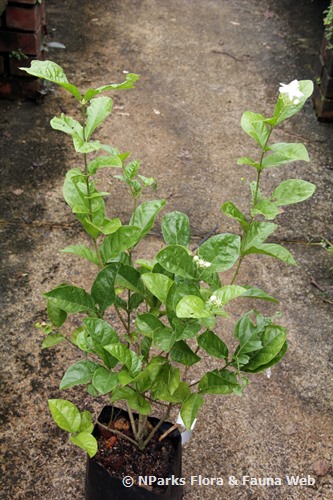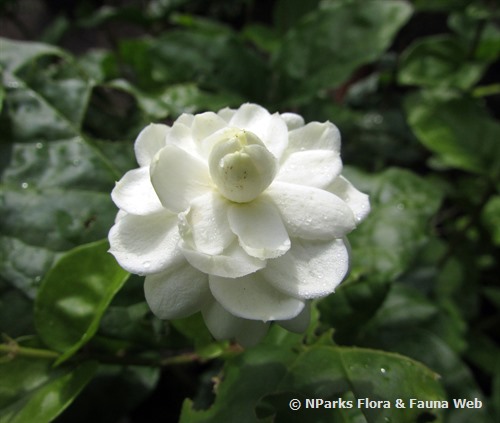
Back
Jasminum sambac 'Arabian Nights'
| Family Name: | Oleaceae |
| Common Name: | Arabian Jasmine, Sambac, Pikake, 茉莉 |
Name
Classifications and Characteristics
| Plant Division | Angiosperms (Flowering Seed Plants) (Dicotyledon) |
|---|---|
| Plant Growth Form | Climber, Shrub |
| Lifespan (in Singapore) | Perennial |
| Mode of Nutrition | Autotrophic |
Biogeography
| Native Distribution | India |
|---|---|
| Preferred Climate Zone | Tropical |
Description and Ethnobotany
| Growth Form | It is a shrub with a climbing habit, can grow as a shrub or vine up to 1.5 m long. |
|---|---|
| Foliage | Leaves are light green, paired. |
| Flowers | Fragrant flowers, white, similar shape as 'Maid Of Orleans' but is double-petaled. |
| Fruit | Fruits are small black berries, but seldom seen in cultivation. |
| Similar | Very similar with another cultivar J. sambac 'Maid Of Orleans'. It can be distinguished based on these characters below: 'Maid Of Orleans' have similar petal shape like 'Arabian Nights' but single-flowered (having less number of petals) and their leaves are arranged in pairs. |
| Cultivation | Grow plants outdoors, this plant can grow under full sun (as a shrub) or shade (as a vine, with bigger and darker leaves). Keep plants on the dry side and avoid soggy conditions, water only when the soil is dry. The soil must be well-drained and moist. Pruning helps to increase flowering as new wood produces new shoots. Fertilize monthly with a balanced fertilizer. |
| Etymology | The genus Jasminum is latinized from the Persian name, yasemin or Arabic, yasamin, for perfumed plants. The specific epithet sambac is an Arabic name, zambac. |
| Ethnobotanical Uses | Others: The flowers are brewed as tea. Flower buds are sewn and used in garlands (or lei) in India. |
Landscaping Features
| Landscaping | It is suitable as a houseplant as it can grow under sun or shade. But will flower best under sunny conditions. |
|---|---|
| Desirable Plant Features | Ornamental Flowers, Fragrant (Flowers) |
| Landscape Uses | General, Parks & Gardens, Small Gardens, Trellis / Arbour / Pergola, Flowerbed / Border, Container Planting |
| Thematic Landscaping | Fragrant / Aromatherapy Garden |
Plant Care and Propagation
| Light Preference | Full Sun |
|---|---|
| Water Preference | Moderate Water |
| Plant Growth Rate | Moderate |
| Rootzone Tolerance | Moist Soils, Well-Drained Soils |
| Propagation Method | Stem Cutting |
Foliar
| Foliage Retention | Evergreen |
|---|---|
| Mature Foliage Colour(s) | Green |
| Mature Foliage Texture(s) | Glossy / Shiny |
| Foliar Type | Simple / Unifoliate |
| Foliar Arrangement Along Stem | Opposite |
| Foliar Attachment to Stem | Petiolate |
| Foliar Shape(s) | Non-Palm Foliage (Ovate) |
| Foliar Venation | Pinnate / Net |
| Foliar Margin | Entire |
Floral (Angiosperm)
| Flower Colour(s) | White |
|---|---|
| Flower Texture(s) | Smooth, Waxy |
| Flower Grouping | Cluster / Inflorescence |
| Individual Flower Shape | Tubular |
| Flowering Period | Free-Flowering |
Image Repository
Others
| Master ID | 144 |
|---|---|
| Species ID | 5208 |
| Flora Disclaimer | The information in this website has been compiled from reliable sources, such as reference works on medicinal plants. It is not a substitute for medical advice or treatment and NParks does not purport to provide any medical advice. Readers should always consult his/her physician before using or consuming a plant for medicinal purposes. |








